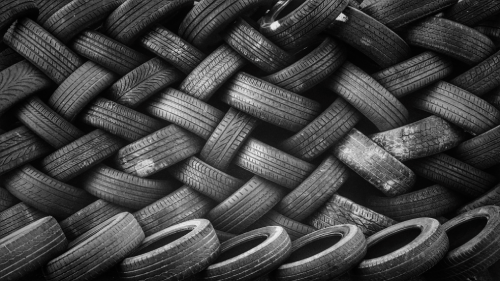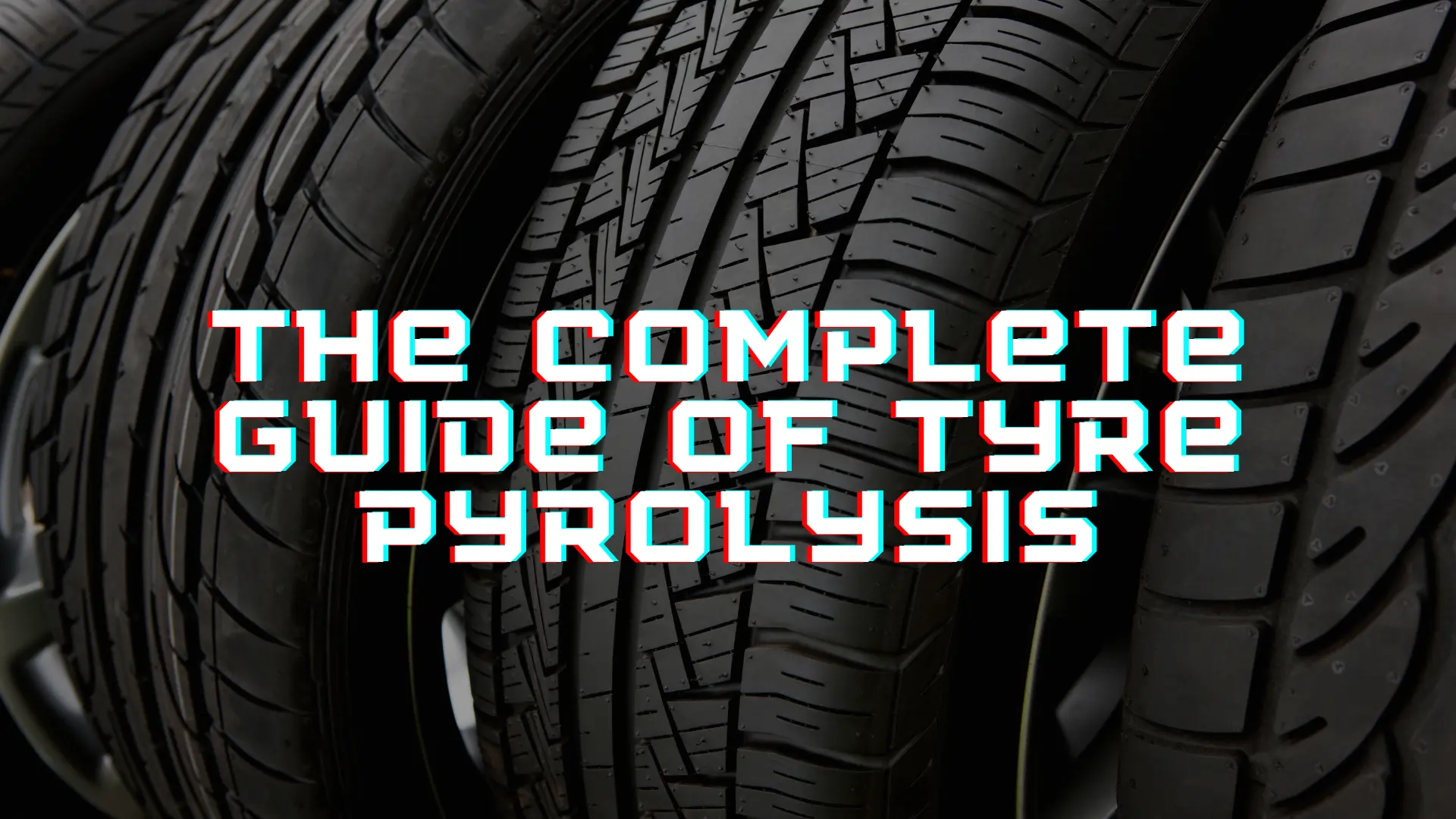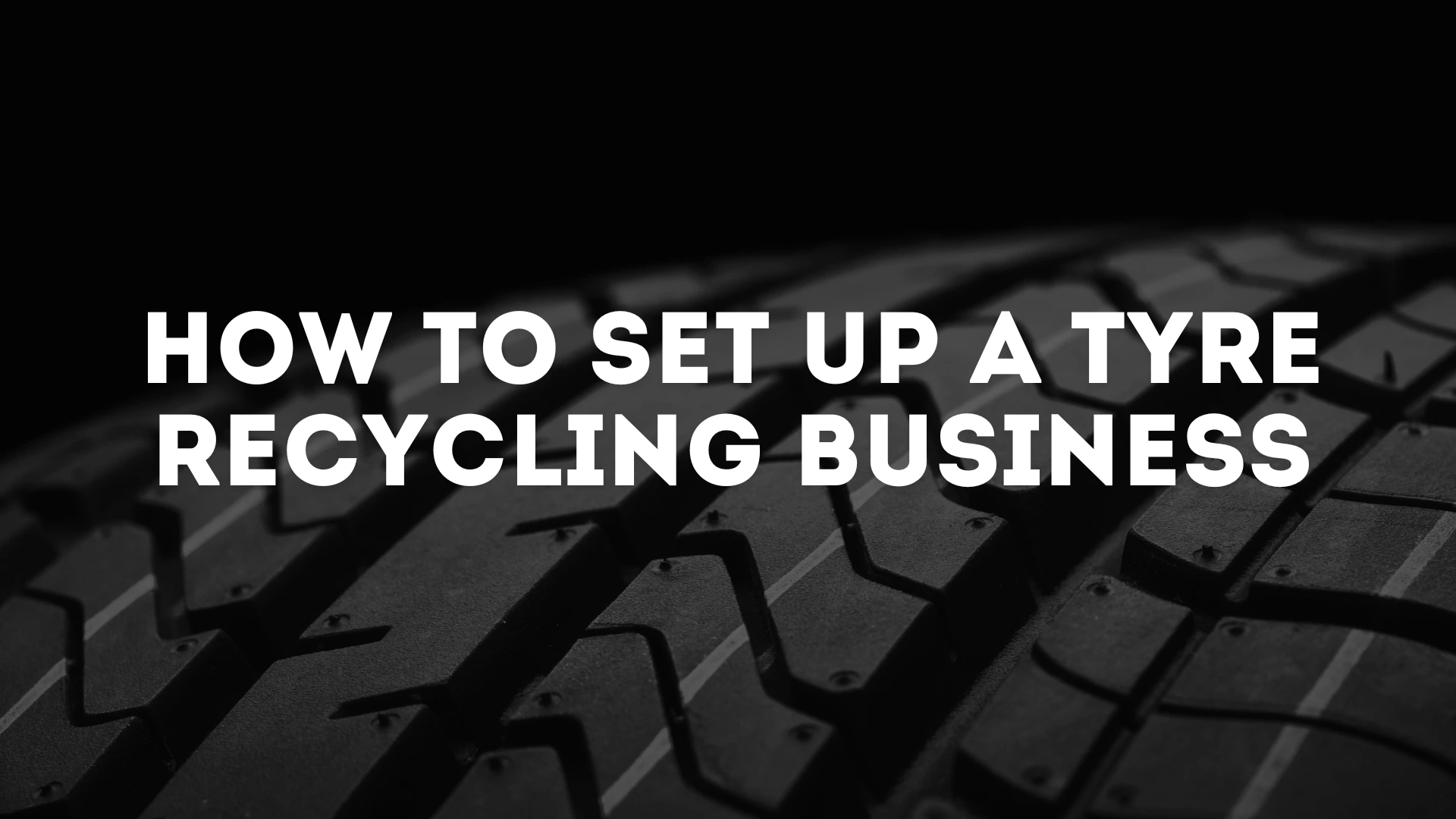Tyre pyrolysis is one of the popular methods used to manage tyre waste. Every year over 1.6 billion new tyres are generated and around 1 billion of waste tyres are generated. Have you ever wondered how this one billion waste tires are managed? Tyres have a lengthy lifespan and cannot biodegrade, making tyre disposal a difficult task. Stockpiling, illegal dumping, or landfilling have all been conventional methods of disposing of used tyres. But these are all temporary fixes! And when it comes to recycling used tyres, there are three main methods:
- ambient mechanical grinding,
- cryogenic grinding, and
- tyre pyrolysis.
In this blog we are going to talk about tyre pyrolysis in detail.
What do you mean by Tyre pyrolysis
Tyre Pyrolysis is a thermal conversion of materials at high temperatures in an inert atmosphere. Tyre Pyrolysis can be obtained through thermal or catalytic pathways. Thermal pyrolysis is known for its high operating temperature, reaction time, and low oil quality. Catalytic pyrolysis of the used tyre has been developed with the use of a catalyst in order to overcome the difficulties associated with thermal pyrolysis. Infact 60% to 80% of the used tyres can be converted through catalytic pyrolysis into pyro-oil, which is very comparable to diesel fuel. As a result, the pyro-oil that is created is of higher quality and may produce useful compounds that are used as feedstock in chemical processes and energy-related applications like the production of electricity, fuel for transportation, and a source of heat.
Parameters that influence the yield of tyre pyrolysis products
The distribution of gas, liquid, and solid phase pyrolysis products and their physical and chemical characteristics are mostly influenced by temperature . Other important variables include-
- the heating rate,
- the particle size,
- the feedstock composition,
- the pyrolysis time and
- tyre residence time,
- the carrier gas flow rate and volatiles residence time,
- the atmospheric pressure and
- type (including the presence of steam in the carrier gas) of the tyre
- the presence of a catalyst.
We will go into detail about temperature and catalyst parameters in detail. As it plays a very important role in the Tyre pyrolysis process.
Tyre pyrolysis temperature
To thermally breakdown the tyres, the pyrolysis temperature must be high enough; however, higher temperatures and prolonged gas residence durations in the reactor hot zone can cause the oil to volatilize into gas . Thus, an optimal temperature exists for maximising oil production. Since oil is the most valuable of the products, maximising oil output is usually the aim.
The studies show that the optimal temperatures for tyre pyrolysis oil production range from 425 °C to 720 °C, with maximum yields falling between 38% and 60%. It is likely that variations in heating rate, gas residence time, reactor type, tyre mass flow rate, and tyre particle size are to account for this significant variation in ideal temperatures and maximum yields. These secondary variables can especially affect secondary reactions that change liquid chemicals into gases or solid compounds into gases.
Catalyst used in tyre pyrolysis
The pyrolysis rate, oil quality, oil yield, and yields of chemicals like aromatics for chemical synthesis can all be improved by catalysts. Dung, et al. (2009) employed ITQ-21 and ITQ-24 as additions to commercial HMOR zeolite for catalytic pyrolysis of waste tyres to increase pyrolysis rate and oil quality. They demonstrated how the catalyst-to-tire ratio affects the pyrolytic oil’s ability to produce gasoline, kerosene, and asphaltenes.
Expanded perlite, a volcanic rock mostly composed of silica and alumina, was heated to 850–1000 °C by Kar (2011) in order to form a porous catalyst support. Metals were then added to the support to act as catalysts. With a perlite to waste tyre ratio of 0.10. Oil yield improved from 60.0 to 65.1 weight percent. The heating value, density, viscosity, and elemental composition of the produced fuel were on par with those of standard petroleum fuels. Using 10% activated alumina, Ates et al. (2005) increased oil output and oil aromatic content. Williams and Brindle (2003) used Y zeolite catalyst (CBV-400 and CBV-780) and zeolite ZSM-5 to increase the concentrations of aromatics, naphthalenes, and alkylated naphthalenes.
Tyre pyrolysis plant types
1.Continuous waste tyre pyrolysis plant
Waste tyres are fed directly into the furnace in this closed-loop system, where they are treated until final goods are produced. Such a tyre pyrolysis tank plant is capable of operating nonstop for weeks or even months. These plants are also regarded as eco-friendly because of their compact arrangement.
Process of continuous waste tyre pyrolysis plant
Let’s discuss the pyrolysis process of waste tyres. Prior to being sent to the horizontal reactor, the scrap tyres and plastics will first be transported through the auto feeding system. At a temperature of over 100 to 120 degrees Celsius, the anaerobic process of pyrolysis of waste tyres and plastic will begin, and vapours will form that will then proceed to various types of condensing systems to produce oil. It is carried directly to the oil tank by a pipeline.
A portion of the non-condensed gas will also form and be transmitted by a secondary fire retardant damper to the hot air circulation heating system. This non-condensed gas can either be released into the air after passing through our wet scrubber system or it can be utilised in the plant by properly storing it for heating purposes. Thus in total around 50-60 tons of waste can be recycled to obtain the required yield of products.
2. Batch waste tyre pyrolysis plant
The batch waste tyre pyrolysis plant, as its name implies, handles the batch-wise treatment of tyre wastes. It has higher overhead costs and is less environmentally friendly. Nevertheless, a plant of this type produces goods of a higher calibre. The raw material, i.e., waste tyres are not fed immediately to the furnace or boiler for processing, in contrast to the Continuous Waste Tyre Pyrolysis Plant. Instead, they undergo pre-processing by shredding and are made into a 10 Mesh powder before being heated.
The primary distinction between batch type and continuous tyre pyrolysis plants is that the former must be stopped after each process, which lasts 16 to 20 hours per day, in order to remove by-products like carbon and re-feed scrap tyres. Whereas the latter is run continuously for numerous batches without any interruptions. While “continuous type plants” process big quantities of material ranging from 10 to 100 tonnes, “batch type plants” process a maximum of 12 tonnes of material every day. Therefore, only continuous waste tyre plants can be effective for any government initiatives or large-scale waste tyre dealing businesses. While continuous type plants are high in automation and less reliant on manpower, batch type plants have minimal automation and are primarily human operated.
Process of Batch waste tyre pyrolysis plant
In a batch waste pyrolysis plant, the inlet is closed to stop gas flow after mechanical tyre waste is fed into the reactor.
When the reactor is generally 200-300 degrees the cracking reaction begins, and the waste tires vaporise into oil vapour.
The hydrocarbons that enter the condensing system are converted to oil and liquefied before being collected in the tank unit.
The reactor will be cooled following the completion of oil production. The wires and carbon black will be automatically or manually removed when the temperature falls below 40 degrees.
Advantages and disadvantages of tyre pyrolysis
Advantages
- The primary raw material for the waste tyre/plastic pyrolysis plant is waste tyre and plastic scrap, both of which are widely accessible worldwide.
- There is 100% recycle of waste tires, no material is left behind at the end of the process.
- It’s a technologically viable option with low startup costs, abundant material availability, rapid return on investment, and a promising future.
Disadvantages
- Pollution of the air and land is caused by unqualified waste plastic pyrolysis plants because they do not adhere to environmental emission regulations.
- Since pyrolysis technology is a chemical project, you must obtain a permit in order to lawfully carry out such a project in your area. It will demand time and energy.
Main products obtained are –
| Tyre Pyrolysis oil | Oil is combined with light diesel oil which can be used in different boiler companies, rolling mills, casting industries, Asphalt plants etc. |
| Carbon | Used in ink or cement industries |
| Hydrocarbon Gas | Hydrocarbon gas can either be processed through a wet scrubber system to create harmless smoke that is discharged into the atmosphere, or it can be retained and utilised again in the same facility for heating purposes. |
Parts and accessories used in tyre pyrolysis plant
| NO. | Name | Functions |
| 1 | Auto-feeder | Used to feed the raw material into a pyrolysis reactor. |
| 2 | Pyrolysis reactor | This is where the material is heated and pyrolyzed. |
| 3 | Buffer tank | Used to buffer the large amount of oil gas produced and ensure the smooth operation. |
| 4 | Oil tank | Used to store the obtained fuel oil. |
| 5 | Two vertical condensers | Used to cool oil gas. |
| 6 | Oil-water separator | Filter and clean the oil gas, preventing the backflow. |
| 7 | Two horizontal condensers | Used to cool oil gas. |
| 8 | Two cooling tower | Used to cool oil gas. |
| 9 | Tail gas cleaning and odour removal system | Used to clean and remove odour of tail gas. |
| 10 | Desulfurization & purification tower | Used to purify the smoke. |
| 11 | Wind conveying system | Used to collect carbon black. |
| 12 | Grinding machine | Used for further processing of carbon black, refined grinding powder. |
Tyre pyrolysis process of waste tyres
Tyre pyrolysis is the process of converting used tyres into products like steel wire, carbon black, and fuel oil. It has been established that using green technology is the best way to address the pollution caused by used tyres.
How does pyrolysis work?
- To prepare for shredding the tyres, first utilise the wire drawing equipment to remove the tyre wire.
- To obtain little pieces of tyres, secondly, feed tyres without harsh steel wire into a tyre shredder; shredded tyres are simple to pyrolyze;
- Third, use a closed continuous feeder to feed the shredded tyres into the pyrolysis reactor and heat it with fuel. By using automatic feeding, this step can lower labour costs and investment.
- Four, oil gas is produced when the pyrolysis reactor is heated to a particular temperature. Oil gas then passes through a three-stage cooling system, which includes a cooling tower, a horizontal condenser, and a vertical condenser, to be cooled down in order to obtain oil and enter oil tanks;
- Five, after being cleaned by a tail gas cleaning and odour removal system, the non-condensable gas leaving the cooling tower can be recycled to heat the reactor;
- Sixth, smoke will be produced during fuel combustion and can be released after being cleaned up by a smoke cleaning system;
- Seventh, the carbon screw conveyor can finally collect the carbon black in the pyrolysis reactor.
Waste tyre pyrolysis plant cost
Waste tyre pyrolysis can provide enormous profits for the business because of the rising energy demand and the cost of constructing a waste tyre pyrolysis to fuel plant is primarily broken down into four components:-
| Cost of Machine | Machines for pyrolyzing waste tyres into fuel range in size from 500 kg to 60 t and cost from 18 000 USD to 65 000 USD. Additionally, the cost may change based on the various configurations you pick to satisfy your needs for automation, energy efficiency, environmental protection, and other factors. |
| Cost of freight | One 40’HC container is all that is required to ship a 500 kg waste tyre pyrolysis to fuel machine; two 40’HC containers are required to ship a 1 t waste tyre pyrolysis to fuel machine; and at least one 40’HC and one 40’FR container are required to ship a 10/12/15 t waste tyre pyrolysis to fuel machine, with the freight of the 40’FR container being roughly three to four times that of the 40′ However, freight to different nations and freight to the same country at various periods are also different. |
| Cost of installation | You’ll need to hire some technicians when you install the waste tyre pyrolysis to the fuel machine. Hence, you must pay our engineer’s and our employees’ wages. |
| Cost of factory/land | You must first prepare a factory or site before installing the waste tyre pyrolysis to the fuel machine. For a modest 500 kg or 1 t machine, you will need 30-40 sq metres of land, and this is just for the machine; you also need to think about material storage and finished product storage. You would require at least 30x15m of land for a normal 10/12/15t waste tyre pyrolysis to fuel machine. |
We have now discussed tyre pyrolysis, including how it operates, the many types of plants, and how much it costs to set them up. Let’s now discuss the end results of the process. The four main products of tire pyrolysis by weight/volume in descending order are-
- fuel oil,
- carbon char,
- steel wire and
- gas.
Tyre pyrolysis oil
One of the beneficial components produced by pyrolyzing used tyres is tyre pyrolysis oil, a complex mixture of hydrocarbons. Tyre pyrolysis oil used as a fuel in combustion systems is a viable method for recycling waste tyres due to its high energy density (HHV 43 MJ/kg). The tyre pyrolysis oil contains compounds made of several hydrocarbons, ranging in size from C5 to C20, and it can be utilised as a substitute energy source to assist minimise the usage of petroleum fuels and their tendency to become more expensive.
Oil makes up approximately 35-45% of pyrolysis output depending on process conditions.
Tyre Pyrolysis Oil Specifications
| Sr.No. | SPECIFICATIONS | UNITS | TEST_RESULTS | STANDARD VALUE |
| 1. | KINEMATIC_VISCOSITY_AT 40°C | CST | 9.00 | 2.4– 15.7 |
| 2. | ACIDITY, TOTAL | mgKOH/gm | 0.01 | NIL |
| 3. | ASH | % BY WT | 0.005 | 0.02 |
| 4. | FLASH POINT, COC | °C | 40 | 66 MIN. |
| 5. | WATER CONTENT | % BY WT | NIL | 1.0 MAX. |
| 6. | POUR POINT | °C | + 6 | 12 – 18 |
| 7. | DENSITY AT 27°C | gm/cc | 0.907 | TO REPORT |
| 8. | SEDIMENTS | % BY MASS | 0.02 | 0.10 |
| 9. | TOTAL SULPHUR | % BY MASS | 0.65 | 1.80 |
| 10. | COPPER STRIP CORROSION TEST FOR 3 HRS AT 100°C | NO UNITS | 1b | 1 MAX |
| 11. | GROSS CALORIFIC VALUE | KCAL/KG | 10,200 | ABV.10000 |
fig: Pyrolysis Oil Specification
Tyre pyrolysis oil purification
Since the pyrolysis tyre oil is made up of several fractions, we first separate them. Typically, distillation technology is used to accomplish this. The various parts of the pyrolysis tyre oil would be distilled out and separated at various temperature levels.
Tyre pyrolysis oil distillation process-
In general, the distillation process of tyre pyrolysis oil mainly includes the following steps:
- Feeding- In order to fill the distillation reactor with tyre pyrolysis oil, turn on the oil pump and then fill the reactor to capacity before shutting the door.
- Distillation- Activate the burners to begin heating the reactor. The oil-gas will keep on being continually distilled out as the temperature rises.
- Cooling- The pipeline will allow oil-gas to enter the cooling system. Oil-gas will become liquid oil and enter the oil tank after being cooled by the cooling system’s circulating water. The circulating water can be recycled, and the oil-gas won’t come into contact with it.
- Decolorization and deodorization- Through the oil pump, the liquid oil in the oil tank is pumped into the decolorization and deodorization tanks in order to remove the wax and gum present therein as well as the disagreeable smell of the liquid oil.
- Further purification- In most cases, after the last procedure, you already had diesel of high grade. You can add a filtration system to the diesel to further filter it if you desire better-quality, light-yellow-coloured diesel.
Ultimately, you can acquire 10% asphalt and 85% better-quality diesel. 5% of the exhaust gas can be utilised to heat the reactor to conserve fuel. Diesel can be used in ship engines, boilers, generators, burners, construction equipment, and other gear. The asphalt can be supplied to asphalt factories or utilised for paving.
Difference between tyre pyrolysis oil and distillation diesel
| Tyre pyrolysis oil | Distillation diesel |
| Waste tyres are pyrolyzed to produce tyre pyrolysis oil as the byproduct. Oil components can be found in waste tyres. Waste tyres can be converted into roughly 45% pyrolysis oil, 35% carbon black, and 15% steel wire when heated inside a pyrolysis facility with no oxygen present. | After being processed by pyrolysis oil distillation plants, distillation diesel is the end product of tyre pyrolysis oil. In addition, this device may also be used to convert used engine or motor oil into distilled diesel. Distillation, cooling, a decoloring and deodorising system, and a high diesel production system are all included in the entire refining process. |
| Tyre pyrolysis oil produces a thick polymer precipitate and has a dark brown hue when exposed to air because it includes a lot of unsaturated chemicals including diolefins and aromatic hydrocarbons. | Distillation diesel is mainly composed of carbon, hydrogen and some oxygen. The colour is tea yellow or brown. |
| To replace furnace oil or industrial diesel, tyre pyrolysis oil is a common industrial fuel. The fuel oil is mostly used in machinery that does not require high quality fuel oil, such as steel factories, boiler heating, cement factories, even heavy oil generators, etc. | If refined, distillation diesel can be produced, which can be used for heavy machinery, heating, diesel generators, etc. |
Tyre pyrolysis oil uses
- Directly used as fuel oil– Tyre pyrolysis oil has a high heating value (10592.48 Kcal/kg), making it a direct replacement for fuel oil in industrial or boiler heating systems, such as those in cement plants, steel plants, glass plants, and other similar facilities.
- Used to generate electricity -Electricity is out of reach for some nations because of the limited supply and high cost of electricity. In this instance, heavy oil generators can utilise the high-quality tyre pyrolysis oil produced by operating a waste tyre pyrolysis machine. In order to effectively address the issue of a lack of power, it can be utilised to directly create electricity from large generators and then be sold to the national grid. Additionally, some nations provide free land and raw materials to their consumers as subsidies.
- Further processed into diesel– Tyre pyrolysis oil can also be processed to create diesel fuel for heating systems, power plants, and agricultural equipment such trucks, ships, generators, people lifts, etc.
The tyre pyrolysis oil is crude oil or HFO, which may be utilised right away as industrial fuel oil, and it comes directly from the tyre pyrolysis plant. If diesel fuel is the desired end product, a pyrolysis oil distillation plant is another manufacturing line that is required.
Tyre pyrolysis carbon black
The second-most important product from the tyre pyrolysis plant is the carbon black, which is between thirty and thirty five percent of the total. A substantial amount of the plant’s income could come from the carbon char made from tyres, which may seem like an economically desirable and valuable product. Contrary to popular belief, carbon char is a difficult commodity to market. The term “carbon char” (also known as “pyrolysis carbon black,” “alternative carbon black,” or “recovered carbon black” or “rCB”) refers to a mixture of carbon, ash, zinc, and sulphur. rCB’s qualities are similar to but also less desirable than those of high-value virgin grades of rCB. The price of rCB, the plant’s overall profitability, and the profit margins will all be significantly impacted by the degree of purity and level of treatment the finished product requires.
Tyre pyrolysis carbon black properties
The three main properties of tyre pyrolysis carbon black include:
- Particle size– When carbon black is combined with resins or other carriers, the essential attribute that most influences blackness and dispersibility is the diameter of the spherical particles.In general, the blackness of carbon black increases with decreasing particle size.However, because of an increase in coagulation force, dispersion becomes challenging.
- Structure– The structure’s size has an impact on the blackness and dispersibility of carbon black, much like particle size does. In general, larger structures have better dispersibility but less darkness. Particularly carbon black with a more complex structure demonstrates a strong conducting property.
- Surface chemistry– On the surface of carbon black, there are several functional groups. Depending on the kind and quantity of the functional groups, carbon black’s affinity for inks or paint varnishes varies.
With the addition of a significant amount of hydroxyl groups by oxidation, carbon black exhibits a good dispersibility and a significantly increased affinity for printing inks or varnishes.
In short, when these three primary qualities are combined with inks, paints, or resins, they significantly influence practical properties like blackness and dispersibility.
Carbon powder from tyre pyrolysis uses
- Colouring Agent for Ink and Paints- Carbon black is frequently used in newspaper inks, printing inks, India inks, and paints because it has a higher tinting strength than iron black or organic pigments. For printer ink or toners, carbon black is also utilised as a black pigment.
- Shields from UV rays and prevents plastic ageing- Due to its great light absorption, carbon black may effectively stop the photooxidative deterioration of polymers when they are exposed to sunlight. The experiment shows that a perfect UV shielding effect may be obtained at 2% carbon black concentration with a specific fineness. It is frequently used for conductive packaging, films, fibres, mouldings, pipes, and semi-conductive cable compounds in products like refuse sacks, industrial bags, photographic containers, agriculture mulch film, stretch wrap, and thermoplastic moulding applications for automotive, electrical / electronics, home appliances, and blow-moulded containers.
- Electric Conductive Agent- The crystal structure of carbon black particles is similar to that of graphite, which allows for good electrical conductivity. As a result, carbon black is a common conductive filler that is added to paints, elastomers, pastes, films, and plastics.
- Automobile gasoline caps and fuel-intake pipelines, for instance, need to be electrically conductive to prevent static. As a result, carbon black is a highly effective antistatic agent.
Tyre pyrolysis gas
The percentage of gas produced by tyre pyrolysis is the smallest. The gas generated during the thermal breakdown has a high enough calorific value to power the process. As a result, the majority of pyrolysis facilities are nearly energy self-sufficient, and some of them can even generate electricity. Pyrolysis gas, also known as residual gas, is typically burned either inside the reactor or in the turbine. The gas cannot be sold as fuel due to complexity and purification issues. Consequently, there is a better way to turn it into power. Gas and heating oil can both greatly increase the commercial viability of a tyre pyrolysis plant given the current high cost of electricity.
Tyre pyrolysis gas composition
Tyre pyrolysis gases are composed of CO, CO2, H2S, and hydrocarbons such as CH4, C2H4, C3H6, C4H8, etc. and its unsaturated derivatives.
| S.No | Gas type | Composition at different reactor temperature(°c) | |||
| 500 | 600 | 600-800 | above 800 | ||
| 1 | CH4 | 24.18 | 7.12 | 8.63 | 9.4 |
| 2 | CO | 6.24 | 0.38 | 0.65 | 0.82 |
| 3 | CO2 | 8.23 | 0.18 | 0.19 | 0.21 |
| 4 | C2H4 | 7.4 | 5.33 | 6.8 | 4.48 |
| 5 | C2H6 | 9.28 | 0.2 | 0.48 | 0.56 |
| 6 | C2H2 | – | 0.29 | 0.36 | 0.89 |
| 7 | C3H8 | 6.21 | 0.71 | 0.97 | 0.52 |
| 8 | C4H10 | 18.28 | 0.59 | 0.62 | 0.39 |
| 9 | H2 | 11.71 | 6.95 | 12.31 | 18.1 |
Tyre pyrolysis waste
- Waste gas– In the process of waste tyre pyrolysis , two types of waste emissions are created. The first is the tail gas that is created in the pyrolysis reactor as the waste tyre is pyrolyzed. The exhaust gas produced when heating the pyrolysis reactor is the other. Non-condensing but combustible gas is the first kind of waste gas, and it will be used once more to heat the pyrolysis reactor. A flue gas purification system, which consists of a desulfurization and purification tower, a pulse dust collection, and a water dust scrubber, will purify the second type of exhaust gas.
- Wastewater- All of the water used in the waste tyre pyrolysis facility is circulated water. There is no discharge of wastewater.
- Waste solid– Carbon black is the residue left in the pyrolysis reactor of a waste tyre pyrolysis plant. It is a by-product of the pyrolysis of used tyre waste. It can be directly sold, compacted into briquettes for fuel, or powdered into powder to create pigments.
What is the environmental impact of waste tyre pyrolysis plants?
The environment has long been a concern in modern living. Waste tyre pyrolysis plants turn waste tyres into fuel oil, which is beneficial to preventing waste tyre pollution. Perhaps you’re interested in learning whether secondary pollution will be created during processing at the waste tyre pyrolysis plant. Short answer: No, when done correctly, it is not harmful.
To start, let’s look into the reasons why production plants can be harmful for the environment.
- Incomplete pyrolysis
Even with the use of clean, virgin wood, partial pyrolysis results in the production of dioxins, hexanes, and furans when the gas treatment at the exit is insufficient. In the event that this occurs due to subpar quality control, the syngas must first be burned at a high temperature before being expelled. This prevents any hazardous substances from leaving the plant.
- No gas recycling
The syngas from almost all pyrolysis processes must be recycled. Without it, pyrolysis would consume a lot of fuel. The majority of technologies already accomplish this to save money and save the environment. But those that don’t recycle their syngas, such small, homegrown technology or ancient systems, let these gases escape and fuel climate change. This indicates that atmospheric releases could increase by twofold rather than being carbon neutral, due in part to the usage of fossil fuels and in part to the avoidance of using the fuel that is created. Therefore, even if they produce biochar, modest home-based pyrolysis systems or ancient techniques that are frequently perceived as being good for the environment may really cause environmental harm.
- High oxygen entrance
Pyrolysis, as defined, is the heating of carbonaceous material in a condition where oxygen is virtually absent. This process enables the recycling and use of carbon in solid, liquid, and/or gaseous phases. In some technologies, the pyrolysis procedure might include a specific amount of oxygen. . When a lot of oxygen enters the process at very high temperatures, we call it combustion or incineration. It is not pyrolysis. At this point, the energetic byproducts that are produced in the form of solids or gases are simply burned, and the energy is squandered unless it is recovered to produce electricity or other forms of energy. All of the carbon in the feedstock is released during combustion and incineration, largely as CO2, into the environment. Making use of this energy is therefore essential to counterbalance the gaseous emissions to the atmosphere.
- Tyre pyrolysis explosion
There will be a risk of explosion if a technology unexpectedly permits a burst of oxygen in the system due to a defect or manipulation. To counteract this, most modern systems incorporate security features (typically three or more).
- Inappropriate storage and transport
From another angle, care must be taken when handling, storing, and transporting char or other liquids like oil, tar, and wood vinegar. Since char is frequently flammable, putting it in exposed containers or even piling it outside may cause fires. It is well known that flames cause pollution, in part because of the particles they emit, which could be hazardous to both human and animal health. Black carbon, char, biochar, and biocoal can all produce a lot of dust. Despite not being immediately hazardous, airborne particles encourage smog and pollution. Thus tyre pyrolysis products should be handled, treated, stored, and transported in a way that is safe for both the environment and the population.
Conclusion
As a safe, effective, and environmentally friendly method of recycling used tyres, tyre pyrolysis is gaining popularity. It is a circular solution that can address the issue of tyre trash while supplying many sectors with inputs that are in high demand. Tyre pyrolysis promotes circularity, which replaces fossil-based raw materials with sustainable substitutes and lessens the environmental effect of the process.
Frequently asked questions
Ques 1: At what temperature does pyrolysis occur
Answer: The pyrolysis process is the thermal decomposition of a wide range of chemicals or materials at temperatures between 400 and 800 °C in an oxygen-free atmosphere or with very little oxygen.
Ques 2 : Is tyre pyrolysis profitable?
Answer: It is profitable to invest in a pyrolysis plant for waste recycling.Pyrolysis plant technology can be implemented with less financial outlay, a large supply of raw materials, a rapid return on investment, and a promising future. This makes it the best investment option. Except for economic benefits, it is also good for the environment.
Ques 3 : What are the advantages of tyre pyrolysis?
Answer:
- Waste tyres and plastic debris are the primary raw materials for the waste tyre recycling pyrolysis plant, and they are widely accessible everywhere in the world.
- We get valuable output products from waste tyres like Pyrolysis Oil, Carbon black powder, Scrap steel wires and Gas, which have great demand in the market nowadays.
- Pyrolysis plant process is a pollution free process, thus making an eco-friendly environment.
Ques 4 : What are the problems with pyrolysis?
Answer:
- Low oil yield
- The normal pyrolysis time is about 8 hours, but if the water content of the tire is too high, the pyrolysis time will reach 10 hours or more.
- Overloading will cause reactor instability. As a result, the feed must exactly adhere to the specifications and cannot be overloaded.
Ques 5 : Can pyrolysis oil replace diesel?
Answer: Researchers have been working hard to develop combustible pyrolysis oil from waste plastic or tyre material as an alternative fuel for diesel engines. According to the economic study, pyrolysis oil can replace diesel in terms of engine performance and energy output if its cost is not more than 85% of diesel oil.










